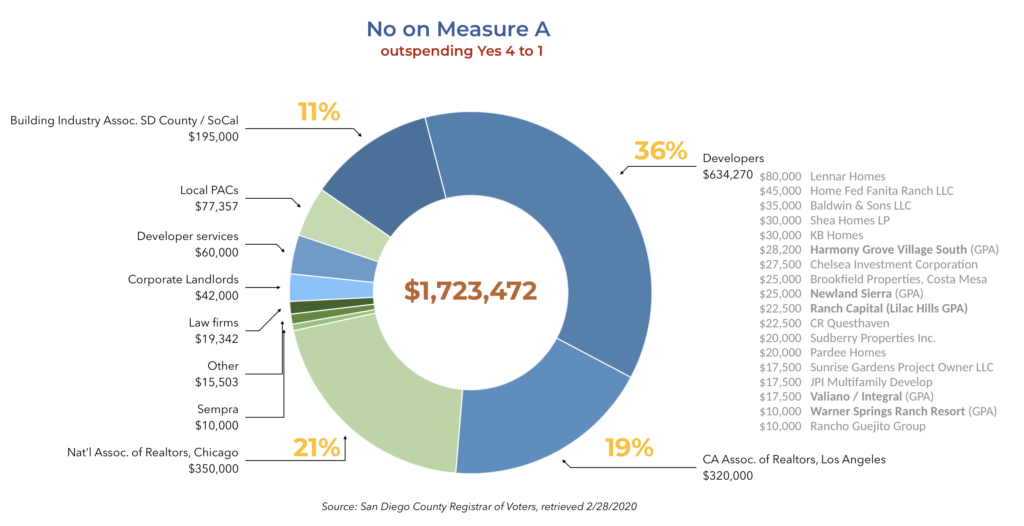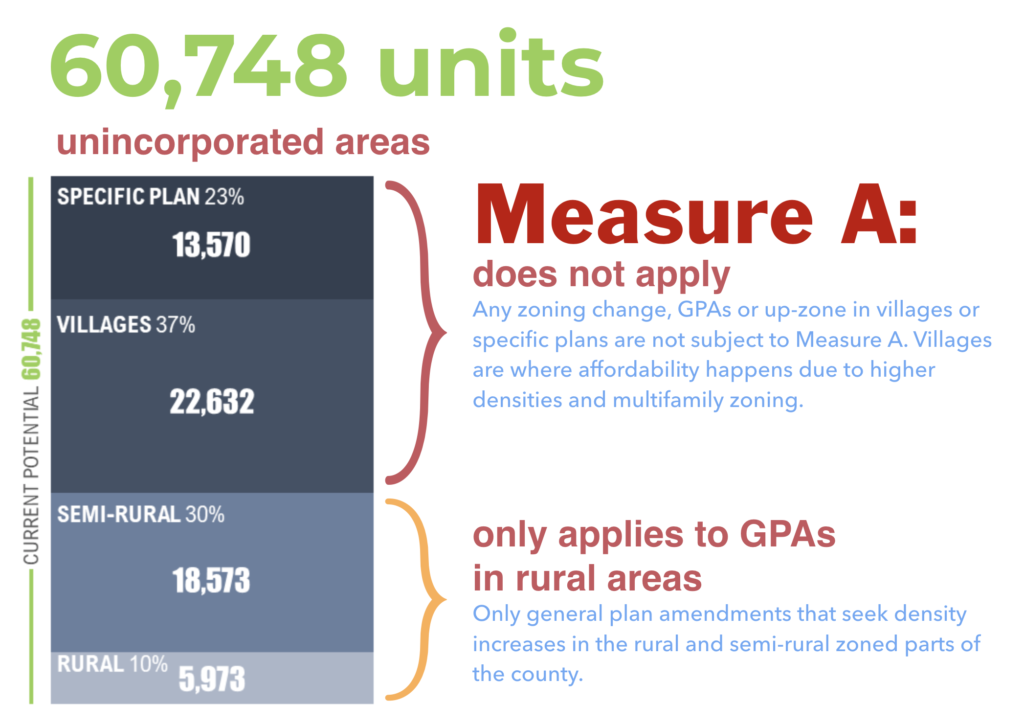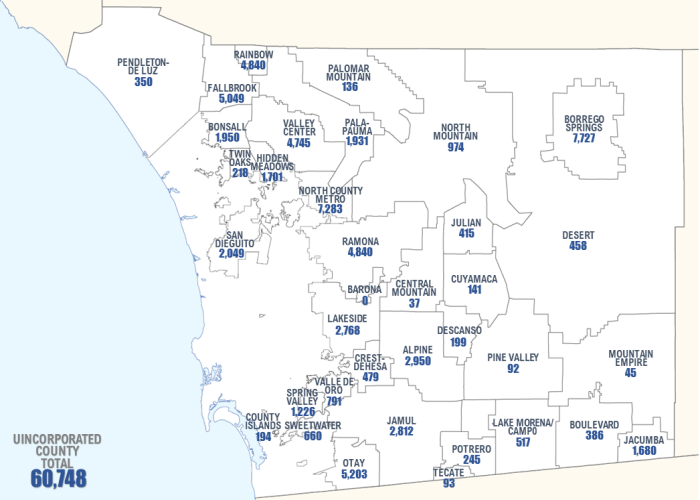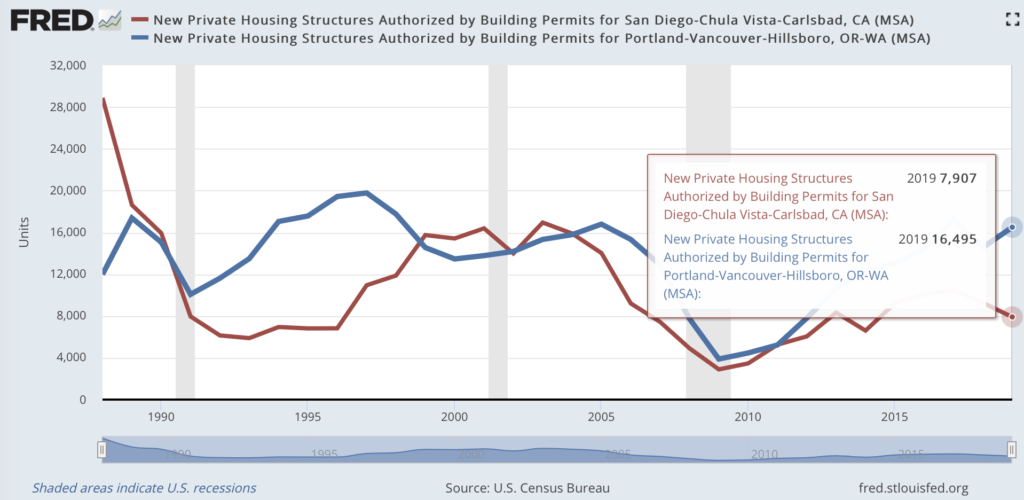Share post via this link: permalink.
Recent propaganda by the Building Industry Association attempts to assert that the smart growth voter initiative, Measure A, would somehow hinder affordable housing.
Measure A reinforces the General Plan, which places emphasis on housing affordability
San Diego County’s General Plan, approved in 2011, was designed to increase housing affordability for San Diegans across all income levels. Measure A doesn’t change any zoning at all, it simply reinforces the existing smart-growth plan, encouraging developers to build the 60,000 units it plans for instead of trying to rewrite the plan at their convenience for high-end sprawl developments in high fire risk areas far from jobs and services.
Industry mobilizes to defeat Measure A, uses unethical tactics, race card
The forces behind the efforts to defeat Measure A have one main motivation: to protect their ability to speculate on politician-driven zoning changes. The Building Industry Association, sprawl developers and the real estate lobby have spent more than $1.7 million to defeat this grassroots measure. Those funds have been used to confuse and mislead voters.

The No on A campaign has been so malicious in its tactics that Supervisor Dianne Jacob, who had previously planned on staying neutral, felt she had no choice but to endorse Yes on A, stating, “I have no problem with campaigning hard, but some folks against Measure A have gone too far. I can’t sit back while outrageous and offensive claims are being made.”
She was referring to baseless claims by the Building Industry Association that the measure and its supporters were racist. This is fairly ironic coming from an industry who has unequivocally opposed virtually any policies that would reduce the burden on lower income families including rent control in National City, tenant’s rights, inclusionary housing in the City of San Diego, and even the general plan’s own affordability requirements. Their policies have increased displacement of vulnerable populations.
Supervisor Jacob, a Republican, is not the only heavy hitter to endorse Measure A. The Environmental Health Coalition, one of San Diego region’s most respected environmental justice organizations, endorses Yes on A. So does the League of Women Voters, which advocates for good government and smart public policy. San Diego City Council President and Democrat Georgette Gómez counts herself among Measure A’s supporters, as do dozens of current and former elected officials, planning commissioners and environmentalists from throughout San Diego County and across the political spectrum.
Exaggerated fears drive developer lobby campaign
Contrary to alarmism from the developer lobby, Measure A does not change any zoning whatsoever. It simply reinforces the existing general plan which was developed with input from more than twenty-nine communities including low income stakeholders, renters, homeowners, environmental groups and the building industry itself, among many others stakeholders. They held over 700 public meetings across more than a decade. $18 million were spent in planning and environmental studies. The plan, approved in 2011, won numerous planning awards, and made affordability one of its primary objectives. Its housing element (Chapter 6) has thirty specific policies with twenty of them focused specifically on affordability. Including one that requires affordable housing when amending the general plan (policy H-1.9).

Affordability is baked into the General Plan; Measure A reinforces it.
The way the general plan (and by extension Measure A) encourages affordability is by zoning land using village and specific plan zoning, which allows for higher housing density (up to 30 units per acre) including multifamily, townhomes, small lot single family and other housing that is more likely to be affordable.
In fact, the majority of the 60,000 units of future housing growth in the general plan is village and specific plan zoning (according to the county’s own documents). These lands are not subject to Measure A at all. Any housing proposed in these areas, including general plan amendments, are not subject to Measure A. And these are also more likely to be affordable.

In addition, most of the new housing is allocated to planning areas adjacent to cities like Chula Vista, Lemon Grove, Santee, Poway, Escondido, San Marcos, Vista and Oceanside. By planning most of the growth next to existing infrastructure and job centers, the plan reduces the amount of driving, congestion and new infrastructure needed, not to mention reducing 3 million daily vehicle trips and 550,000 tons of CO2 per day. While there is some housing planned in the more rural areas like Borrego Springs, the majority is closer to urban areas. According to County planners, in the recent general plan update, Borrego Springs was downzoned significantly but still maintained a good amount of village zoned land as the assumption was that even rural villages will need to accommodate some growth.

De facto Urban Growth Boundary, prevents sprawl, increases housing opportunity
One of the main principles of the general plan is to shift the focus for development of new housing away from rural lands with high fire risk to areas closer to existing urban and suburban areas, creating a sort of de facto urban growth boundary, similar to Portland’s. According to a Brookings Institute study this type of land use planning (also known as urban containment) actually decreases segregation while also limiting the harmful effects of sprawl, historically, a driver of inequality and segregation.

The state of Oregon’s UGB, which is a state mandated policy that applies to all cities, ensures that urban areas expand only when necessary, thus protecting a greenbelt for open space and agriculture while encouraging growth within the urban limit line. The Portland metropolitan area has roughly 3/4 the population of San Diego County. Despite a policy which limits rural development, they have been able to consistently build more housing than San Diego County for at least 2 decades and in fact, last year, built twice as many housing units than San Diego County despite having a smaller population.

In addition to producing more housing more consistently, Portland also features lower cost housing altogether, affordable for a wider range of income levels. The average home in Portland costs $200,000 less than in San Diego and rents are, on average, $600 per month lower. So clearly, urban containment policies do not hinder housing production or affordability and, according to the Brookings Institute, decrease segregation.
Rural general plan amendments are unwieldy, time consuming and costly to process
It is important to note that Measure A only applies to major changes to the County’s General Plan in rural and semi-rural areas known as General Plan Amendments (or GPAs). These are large projects like Lilac Hills, Newland Sierra and Warner Ranch among numerous others. GPA projects require expensive, time consuming environmental analysis and ultimately, require approval by the Board of Supervisors. This is why they are only considered for projects that number in the hundreds or thousands of units. The smallest GPA project proposed since the plan was approved has been for 92 units. They typically average around 900 units. For investors, the entire basis of getting a return on investments in GPA projects is the assurance that there will be 3 supervisors who will vote to approve the project following this arduous, multi-million dollar entitlement process. It is a risky endeavor, and it is largely decided by political actors where the influence of campaign donations, PACs and lobbyists plays an outsize role.
Despite the industry’s suggestion to the contrary, to date, every one of these projects has violated the General Plan’s affordability requirement (Policy H-1.9), a fact recently affirmed by recent court rulings that invalidated these projects’ approvals, in part, on those grounds. And to boot, the average unit cost for these projects will be at least $650K. Not exactly a good case for affordability.

The industry juggernaut, pulls out all the stops
The Building Industry Association, who has organized and funded the opposition to the No on Measure A campaign, has cynically used lies and unsavory tactics to try to stop this citizens’ initiative, a simple initiative that would allow the public to vote on major changes to the consensus-based general plan in rural areas. As part of this campaign, they have bought endorsements from both parties, they have manipulated the Board of Supervisors to attempt a last-minute ballot language change. They have forced the Union-Tribune to kill a positive story about Measure A. They even appear to have held hostage, well-meaning affordable housing developers, whose $900 million ballot measure would be at risk without their support, come November. Despite all this manipulation, the truth remains the same. Voters will hopefully wade through this morass of misinformation and come to the conclusion that Measure A will be good for the long term benefit of our region.
Voters who care about smart growth, climate change, and a just, sustainable and affordable future in San Diego County should join Grow the San Diego Way in voting for Yes on A.

JOIN OUR MAILING LIST TO BE KEPT UP TO DATE ON THE LATEST IN SAN DIEGO LAND USE AND HOUSING ANALYSIS




